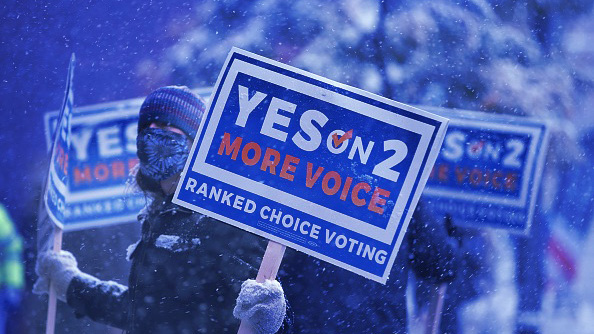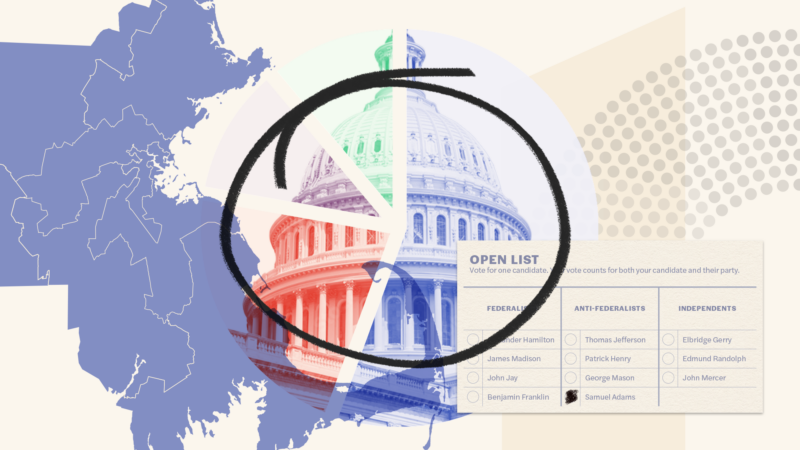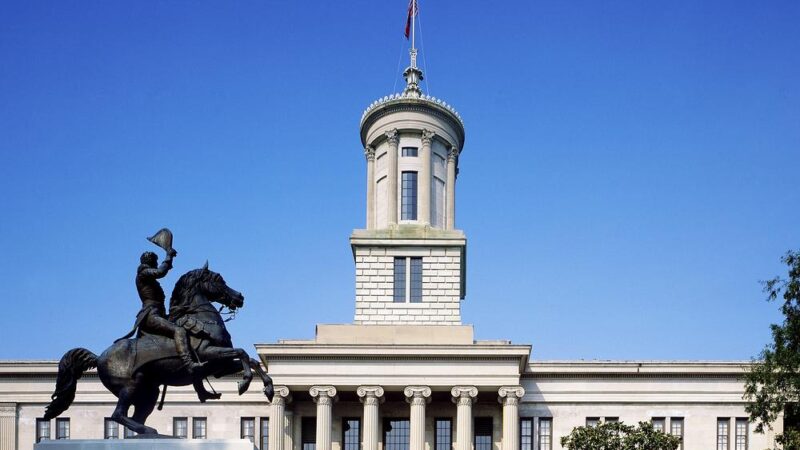Sources of Change: Encouraging Cooperation and Responsibility
- October 16, 2023
From More than Red and Blue: Political Parties and American Democracy

Abstract
The American party system has developed in a distinctive institutional context which traditionally includes partisan primaries, categorical ballots and plurality winners chosen in single-round elections. Reforms in California, Washington State, Maine, and most recently Alaska offer new options — including ‘top-two’ or ‘top-four’ open primaries, ranked-choice ballots and other kinds of majority thresholds — all which are likely to impact inter- and intra-party cooperation and responsible party politics. While some such as Alaska’s “Final Four” system appear promising and are likely to have important impacts on political parties, they are also in their infancy as experimental institutional designs.
The Problem with PartiesThe Problem with Parties
While the U.S. has had two dominant parties since 1860 — the Democrats and the Republicans — their cohesion into distinct and polarized entities is relatively new. Historically, Democrats and Republicans were “big tent” ideologically diverse parties that brought together a grab-bag of interests.1Bensel, Richard Franklin. 1984. Sectionalism and American Political Development. Madison: The University of Wisconsin Press.2Reichley, A. James. [1992] 2000. The Life of the Parties. Lanham, MD: Rowman and Littlefield.3Sundquist, James L. 2011. Dynamics of the Party System: Alignment and Realignment of Political Parties in the United States. Washington: Brookings Institution Press. Until the 1990s, Democrats included a prominent southern-based conservative and moderate wing as well as a larger mainstream liberal wing while Republicans had a sizable northern- based liberal and moderate wing along with a larger conservative wing.4Gimpel, James G., and Jason E. Schuknecht. 2009. Patchwork Nation: Sectionalism and Political Change in American Politics. Ann Arbor, MI: University of Michigan Press.5Phillips, Kevin P. 2014. The Emerging Republican Majority, Updated Edition. Princeton, NJ: Princeton University Press.6Rae, Nicol C. 1989. The Decline and Fall of the Liberal Republicans from 1952 to the Present. New York: Oxford University Press.7Speel, Robert W. [1998] 2010. Changing Patterns of Voting in the Northern United States: Electoral Realignment, 1952-1996. University Park: Pennsylvania State University Press.8Reiter, Howard L., and Jeffrey M. Stonecash. 2011. Counter Realignment: Political Change in the Northeastern United States. New York: Cambridge University Press.
As a result, both parties had many members who overlapped ideologically and in congressional voting, with some Democrats voting more conservatively than Republicans, and vice-versa.9Jacobson, Gary C., and Jamie L. Carson. 2019. The Politics of Congressional Elections, Tenth Edition. Lanham, MD: Rowman and Littlefield.10Lewis, J.B., K. Poole, H. Rosenthal, A. Boche, A. Rudkin, and L. Sonnet. 2022. Voteview: Congressional Roll-Call Votes Database. https://voteview.com. These overlaps facilitated the function of the legislative process despite the increasing commonality of divided government, where one party controls the presidency and the other holds one or both houses of Congress. Even during unified government, this ideological diversity greased the legislative and policy process.
Today, this is no longer the case. American political parties are now far more distinct and homogenous, with substantial ideological space between the most liberal Republican and the most conservative Democrat.11Lewis, J.B., K. Poole, H. Rosenthal, A. Boche, A. Rudkin, and L. Sonnet. 2022. Voteview: Congressional Roll-Call Votes Database. https://voteview.com. Increasingly, they resemble the more disciplined parliamentary parties found in Canada, Germany and the U.K. This does not pose a problem for governance in countries where a Prime Minister can command the support of the House, but it does not work under American institutional arrangements. The combination of party polarization and party discipline severely impedes the compromise required to pass legislation under America’s separation of powers constitutional setup.12Anderson, Sarah E., Daniel M. Butler, and Laurel Harbridge-Yong. 2020. Rejecting Compromise: Legislators’ Fear of Primary Voters. New York: Cambridge University Press.13Drutman, L. 2020. Breaking the Two-Party Doom Loop: The Case for Multiparty Democracy in America. New York: Oxford University Press.
Electoral and institutional rules played a central role in creating this situation. Primary elections have assumed outsized importance as they are the only significant contest in the great majority of congressional elections where one party is heavily favored.14Drutman, L. 2021. What We Know about Congressional Primaries and Congressional Primary Reform. Washington DC: New America Foundation.15Wasserman, David. 2021. “The Biggest Victim in 2021 Redistricting So Far: Competition,” The Cook Political Report, 23 November.https://www.cookpolitical.com/analysis/house/ redistricting/biggest-victim-2021-redistricting-so-far-competition. In a feedback loop spurred on by geographic and demographic sorting along with partisan redistricting16Hill, Seth J., and Chris Tausanovitch. 2015. “A Disconnect in Representation? Comparison of Trends in Congressional and Public Polarization.” Journal of Politics 77 (4): 1058-75.17Lublin, David. 2007. The Republican South: Democratization and Partisan Change. Princeton, NJ: Princeton University Press., primary electorates have become less ideologically diverse and more extreme.18Fiorina, Morris P., Samuel J. Abrams, and Jeremy C. Pope. 2005. The Myth of a Polarized America. New York: Pearson Longman.19Jacobson, Gary C. 2012. “The Electoral Origins of Polarized Politics: Evidence from the 2010 Cooperative Congressional Election Study.” American Behavioral Scientist 56 (12): 1612-630. Most primary challenges to incumbents come from the Left for Democrats and the Right for Republicans, creating incentives for incumbents to shift toward ideological extremes to preempt primary challenges.20Anderson, Sarah E., Daniel M. Butler, and Laurel Harbridge-Yong. 2020. Rejecting Compromise: Legislators’ Fear of Primary Voters. New York: Cambridge University Press.21Harbridge, Laurel, and Neil Malhotra. 2011. “Electoral Incentives and Partisan Conflict in Congress: Evidence from Survey Experiments.” American Journal of Political Science. 55 (3): 494-510.22Mann, Thomas E. 2007. “Polarizing the House of Representatives: How Much Does Gerrymandering Matter?”In Red and Blue Nation?: Characteristics and Causes of America’s Polarized Politics v.1, eds. P. Nivola and D. Brady, 263-83. Washington, DC: Brookings Institution Press.
However, while there is a high degree of consensus that primary electorates today are more polarized and extreme than in the past, scholars dispute whether primary voters are more extreme than the party as a group. Some research contends that low turnout primary contests attract more extreme voters23Fiorina, Morris P., Samuel J. Abrams, and Jeremy C. Pope. 2005. The Myth of a Polarized America. New York: Pearson Longman.24Mann, Thomas E. 2007. “Polarizing the House of Representatives: How Much Does Gerrymandering Matter?”In Red and Blue Nation?: Characteristics and Causes of America’s Polarized Politics v.1, eds. P. Nivola and D. Brady, 263-83. Washington, DC: Brookings Institution Press.25Pew Research Center. 2014. “Political Polarization in Action: Insights into the 2014 Election from the American Trends Panel.” October 17. https://pewrsr.ch/3EZsUf0.26Polsby, Nelson. 1983. Consequences of Party Reform. New York: Oxford University Press., but others find that primary voters closely resemble the party rank-and-file.27See Chapter 6 in this volume.
The ideological sorting of the electorate tends to sideline more moderate voices in the electorate at large and gives priority to a motivated and often ideologically-extreme “selectorate”, regardless of whether primaries result in more extreme nominees than other nomination methods. Given that electoral and institutional rules, especially primaries, played a central role in promoting ideological sorting, there is little reason to expect the system to change when maintaining the same set of electoral incentives. Bluntly put, combined with demographic sorting, electoral reform making primaries the method of choosing most party nominees got the U.S. into this hole and helps maintain polarization. New reforms are likely needed to promote more responsible parties.
Two-Round, Ranked Choice and Other Voting ReformsTwo-Round, Ranked Choice and Other Voting Reforms
Some kinds of electoral reform may help to address these issues. Two-round and ranked choice voting, for instance, can potentially encourage candidates to broaden their support to gain a majority and limit the impact of vote splitting. In each case, the majority requirement for victory incentivizes candidates to seek the support of voters who initially preferred another candidate and enhances the legitimacy of the winner. This places a centripetal counterweight (i.e., pressure to move toward to the center) to the centrifugal forces of sorting, divisive mobilization and negative partisanship.
These reforms could be applied to both primary elections and general elections, separately or in tandem, or to effectively fuse the two into a sequential two-round election featuring a nominating round, in which multiple candidates from the same party can stand, followed by a second round general election in which a specified number of leading candidates from the first round compete for office.
Runoff and Two-Round Elections
Runoff elections can be a feature of both primaries and general elections, as in Georgia; general elections only, as in Louisiana; or (as described above) a sequential two-round combined election which dispenses with partisan primaries altogether, as in California and Washington State’s “top-two” or Alaska’s “top-four” systems. These latter cases effectively shift the responsibility for choosing a parties’ nominee from party members only to all voters.
In general, the need to attract broad support under such systems should advantage candidates with more coalitional appeal, sidelining extremists. However, runoff systems have a mixed record on racial issues: while Arkansas adopted a two-round primary in 1924 to allow anti-Klan voters to coalesce behind a more moderate candidate in the second round28Bullock, C.S. III, and L.K. Johnson. 1992. Runoff Elections in the United States. Chapel Hill: University of North Carolina Press., Mississippi adopted runoffs in 1967 to prevent plurality Black winners.29Parker, F.G. 1990. Black Votes Count: Political Empowerment in Mississippi after 1965. Chapel Hill: University of North Carolina Press.
Evidence from both the U.S. and abroad suggests that a second round of voting almost always encourages some level of bargains and trade-offs between parties and candidates.30Cerrone, Joseph, and Cynthia McClintock. 2021. “Ranked-Choice Voting, Runoff, and Democracy: Insights from Maine and Other U.S. States.” Available at SSRN: https://ssrn.com/abstract=3769409.31Colomer, J. 2004. “The Strategy and History of Electoral System Choice.” In Handbook of Electoral System Choice, ed. J. Colomer. New York: Palgrave. Sartori32Sartori, G. 1994. Comparative Constitutional Engineering: An Inquiry Into Structures, Incentives, and Outcomes. New York: New York University Press. praises the system’s “intelligent choosing” design and “two- shot” nature, which enables voters to have a second choice or even change their mind between the first and second round. Classic runoff systems, which elect the eventual winner by majority, are also less likely to elect insurgent candidates. Blais et alia33Blais, A., J. Laslier, A. Laurent, N. Sauger, and K. Van der Straeten. 2007. “One-round VS Two-round Elections: An Experimental Study.” French Politics 5, 278-286., after arranging several experimental elections, concluded that extremists have almost no chance under such an electoral model.
The ideological sorting of the electorate tends to sideline more moderate voices in the electorate at large and gives priority to a motivated and often ideologically-extreme “selectorate”
The nature of runoffs, however, can result in less than ideal second-round choices or, in exceptional circumstances, even leave voters with two fringe candidates unacceptable to a majority. Peru and Chile faced this situation in their 2021 presidential elections due to vote splitting among more centrist candidates. In Peru, far-left Pedro Castillo and populist-right Keiko Fujimori made it to the runoff with just 18.9 percent and 13.4 percent, respectively. In Chile, the runoff featured far-right José Antonio Kast (27.9 percent) against far-left Gabriel Boric (25.8 percent).
The same could easily have happened in the 2017 and 2022 French presidential elections. The eventual winner in both contests, Emmanuel Macron, gained only 24.0 percent in 2017 and 27.9 percent in 2022. Extreme right candidate Marine Le Pen joined him in the runoff with 21.3 percent in 2017 and 23.1 percent in 2022. But it is not hard to imagine Le Pen along with extreme left candidate Jean-Luc Mélanchon, who won 19.6 percent in 2017 and 21.9 percent in 2022, doing well enough to displace Macron from the runoff.
Closer to home, we have seen quirky outcomes in California’s top-two system. Unlike conventional party primaries in most other states, this requires all candidates to compete in a first round, with the best-supported two moving on to the general election (i.e., second round) — even if one candidate gains a first-round majority or both candidates are from the same party. Occasionally, a surfeit of candidates and vote splitting for the dominant party allows two candidates from the other party to make it to the general election. Besides being vulnerable to outcomes that leave voters with one, or even two, unpalatable choices, studies are mixed on whether the California reforms have promoted less polarized and more responsibly-acting officials. McGhee and Shor34McGhee, E., and B. Shor. 2017. “Has the Top Two Primary Elected More Moderates?” Perspectives on Politics 15: 4, 1053-66. find little evidence, but Grose35Grose, C. 2020. “Reducing Legislative Polarization: Top-Two and Open Primaries Are Associated with More Moderate Legislators.” Journal of Political Institutions and Political Economy, 1: 1-21. argues that new legislators elected under the system are more moderate than the incumbents they replace.36See also Alvarez and Sinclair 2015 and Nagler 2015.
Ranked Choice Voting
Ranked choice voting (hereafter RCV) applied in single-winner contests, also known as the alternative vote, shares some of these same elements (and is sometimes known as instant runoff voting for this reason). Its distinguishing feature is a ballot structure that permits voters to rank candidates in their order of preference. If no candidate is the first choice of a majority, the votes of the candidate with the fewest first preferences are redistributed to the candidates ranked next by each voter. The process repeats until a candidate has a majority of all valid unexhausted ballots and is declared elected.
Maine adopted this approach starting in 2018 for its federal primaries and general elections, as did Alaska in 2022 for all state and federal general elections (as part of its ‘final-four’ voting system discussed below). In both cases, it was voters, not politicians, who delivered these reforms onto reluctant state legislatures via popular initiatives. Support from sitting politicians was lukewarm at best. Activists were motivated by the growing problem of political polarization that rendered state legislatures less workable and the minority victories that were a feature of elections under plurality voting. For instance, both states had elected a succession of minority-supported governors — 8 of the last 12 in Alaska and 9 of the last 11 in Maine.
How are political parties likely to respond? Given that both cases are very recent, the century-long Australian experience with RCV is instructive. When first introduced at the state level in 1907 it was assumed that parties would nominate multiple candidates for RCV elections, effectively using rankings to replace primaries, but this did not occur and parties quickly settled on a single nominee to manage their vote most effectively.37Reilly, B. 2021. “Ranked Choice Voting in Australia and America: Do Voters Follow Party Cues?”Politics and Governance, 9 (2): 271-279. In time, a stable party system developed, underpinned by voters for smaller parties being compelled to express a second or later choice for one or other of the two main parties or coalitions. These major parties compete for the political center, as extremist position-taking risks alienating supporters of other parties and thus losing potential ranking flows from excluded candidates. Despite operating in the highly adversarial system that gives greater power to its disciplined parliamentary parties, this also results in frequent convergence on policy positions by the two major parties (or coalitions) — one reason that polarization is low compared to the United States, despite other similarities.38Reilly, B. 2018. “Centripetalism and Electoral Moderation in Established Democracies.”Nationalism and Ethnic Politics 24 (2): 201-21.
RCV also influences how political parties campaign: “every Australian election is preceded by an intense period of bargaining between the parties as to how they will advise their supporters to rank opposing candidates.”39Farrell, D., and I. McAllister. 2005. “Australia: the Alternative Vote in a Compliant Political Culture.” in The Politics of Electoral Systems, eds. M. Gallagher and P. Mitchell, 79-97. Oxford: Oxford University Press. While American parties have yet to introduce Australian-style “how to vote” pamphlets, such cross-endorsements have been a feature of RCV elections in both Maine and Alaska. Maine’s first elections under the new system in 2018 saw Democrat Jared Golden unseat incumbent Republican Bruce Poliquin in a district that went for President Trump by 10.3 percent in 2016 and 7.4 percent in 2020. Golden won from second place after cross-endorsing two independent candidates, overtaking the plurality-leading Poliquin as a result. Golden subsequently shifted to a more centrist position in Congress than the rest of the Democratic Caucus.
Much depends on how voters use their rankings. In Maine, most voters in the Second District contest followed their chosen party’s signaling. This meant that about two-thirds of Republicans cast a single ranking only, while for Democrats this pattern was reversed, with over 60% ranking at least one other candidate. A 2015 survey in New South Wales, which uses the same form of RCV that is the standard for American elections, found that around half the electorate used multiple rankings while the other half ranked only one candidate, a similar pattern to that seen in Maine. That survey also found older and conservative voters more likely to just issue a single preference and younger progressives more likely to use their full rankings, a pattern that is also likely in the U.S.40Reilly, B. 2021. “Ranked Choice Voting in Australia and America: Do Voters Follow Party Cues?”Politics and Governance, 9 (2): 271-279.
Another issue is candidate and party proliferation. More candidates tend to be associated with numbering errors and greater voter and ballot ‘exhaustion’.41Burnett, C., and V. Kogan. 2015. “Ballot (and Voter) ‘Exhaustion’ under Instant Runoff Voting: An Examination of Four Ranked-Choice Elections.” Electoral Studies 37, 41-49. As a result, emerging best practice in RCV election administration limits the number of rankings offered to voters, for both presentational and practical reasons. The Center for Civic Design42Center for Civic Design. 2018. “Recommendations for Introducing Ranked Choice Voting Ballots’,” July. https://civicdesign.org/wp-content/uploads/2017/07/Introducing-RCV-Ballots-18-0803-FNAL.pdf., for instance, recommends ballots have a maximum of five or six rankings. This advice also conforms with the practical application of RCV in large city elections in San Francisco, Minneapolis, and New York, which limit voters to between three and five rankings, in part to satisfy the requirements of mass elections using voting machines. In Alaska, discussed below, four rankings plus a write-in option are offered. In sum, more than a binary choice is desirable but too much choice can confuse, particularly in the American context, where voters elect a plethora of officials.
Final-Four or Final-Five Voting
A recent innovation intended to address these concerns is the replacement of partisan primaries by a nominating first-round election, with the top four or five candidates going on to compete at a second- round RCV general election. First used by Alaska in 2022, such ‘final-four’ voting (FFV hereafter) systems are designed to winnow the candidate field and then require the general election winner to gain not just a plurality but a majority of the vote for victory.
A top four or five primary means that both traditional and insurgent candidates from one or both parties can potentially make it to the general election.
Allowing multiple candidates from the same party to compete with each other and potentially advance has mixed effects. On the one hand, it gives voters a greater range of choices and injects more competition into general elections. Compared to runoff systems or top-two primaries, this reduces the chance that only a quirky or extreme set of candidates make it to the general election. However, it also reduces the party’s ability to control its nominees and present a disciplined campaign with clear options to voters.
In addition, the effects of running a multi-winner election with a single-choice ballot (rather than having one vote per seat as typical in American at-large elections) mean that FFV’s first round is effectively a single non-transferable vote (SNTV), which has its own distinctive impacts on political parties. Since the system elects the highest-polling candidates regardless of their vote total, some successful candidates will likely attract far more votes than others. International studies of this system at general elections found it forced parties to make strategic choices about the number and support given to their nominees, to avoid nominating too many (and thus splitting their vote) or too few (and thus missing out on potential winnable seats) candidates. But when used in a nominating round, as in Alaska, these strategic dilemmas are less acute. Because there are multiple winners, SNTV elections are also less vulnerable than plurality elections to inadvertent outcomes out of sync with the general voting population, which can often aid the “wrong” or opposing candidate.43Bowler, S., T. Donovan, and J. Van Heerde. 2005. “The United States of America: Perpetual Campaigning in the Absence of Competition.” In The Politics of Electoral Systems, eds. M. Gallagher and P. Mitchell. New York: Oxford University Press.44Duverger, M. 1954. Political Parties: Their Organization and Activity in the Modern State. London: Methuen.45Lijphart, A. 1994. Electoral Systems and Party Systems: A Study of Twenty-Seven Democracies, 1945-1990. New York: Oxford University Press.
A top four or five primary means that both traditional and insurgent candidates from one or both parties can potentially make it to the general election. When combined with an RCV general election, as in Alaska, this offers institutional incentives for parties to modify their erstwhile campaign strategy and thus their approach to electoral competition. In particular, dispensing with the party primary mitigates the need to speak exclusively to party diehards. While encouraging candidates from the same party to try to carve out their own ideological niche or geographic base to gain a place in the RCV general election, it also makes it unlikely that only more extreme candidates make it through to the general election.
The system also promotes more diverse candidate offerings. Mathematically a top-four primary guarantees a slot in the general election to any candidate winning over one-fifth of the vote and, in practice, often allows those with much smaller support levels to gain a seat — meaning candidates with around 10 percent support or less should frequently make it through, as was the case with SNTV in Japan.46Cox, G., and E. Niou, 1994. “Seat Bonuses under the Single Nontransferable Vote: Evidence from Korea and Japan.” Comparative Politics 26: 2, 221-236.47Grofman B. 1999. “SNTV: An Inventory of Theoretically Derived Propositions and a Brief Review of the Evidence from Japan, Korea, Taiwan, and Alabama.” In Elections in Japan, Korea, and Taiwan under the Single Non-Transferable Vote: The Comparative Study of an Embedded Institution, eds. B. Grofman, S. Lee, E. Winckler and B. Woodall. Ann Arbor: University of Michigan Press.48Klein, A. 2001. “Japan.” In Elections in Asia and the Pacific: A Data Handbook. eds. D. Nohlen, F. Grotz, and C. Hartmann. New York: Oxford University Press.49Lin, J. 2006, “The Politics of Reform in Japan and Taiwan.” In Electoral Systems and Democracy, eds. L. Diamond and M. F. Plattner. Baltimore: Johns Hopkins University Press. Accordingly, we can expect third parties or independents to regularly claim a place on the general election ballot. In Japan, the system effectively offered political parties two contrasting strategies: smaller parties should coordinate behind a single candidate while large parties should put forward multiple candidates to maximize their seat haul — but not so many as to risk splitting the vote.
Alaska’s 2022 statewide contests (for Governor, U.S. House, and U.S. Senate) confirmed this comparative experience, suggesting that FFV promotes candidate diversity while also facilitating voter choice. The percentage of the first-round vote required to advance to the top-four RCV general election ranged from 2.2 percent to 10.1 percent, a low barrier to entry even with only four candidates making it to the general election. In all the federal contests, the top-four included at least one Democrat, one Trumpist Republican and one non-Trumpist Republican. The gubernatorial contest did not include a non-Trumpist Republican but featured centrist independent former Gov. Bill Walker. In every case, FFV prevented winnowing out of more centrist candidates, such as incumbent Republican Sen. Lisa Murkowski (who won re-election under the new system but would likely have lost a closed primary election) or new Alaskan House Rep. Mary Peltola (a Democrat who built a sustained statewide following after finishing a distant fourth in the first-round election). Joint campaigns and cross-endorsements across party lines, an indicator of moderation and accommodation, were a feature of both campaigns.50Reilly, B., D. Lublin, and G. Wright. 2023. “Countering Polarization or ‘Crooked as Hell’? Alaska’s New Electoral System.”California Journal of Politics and Policy 15 (1): 1-19.
Such cross-partisan, split-ticket voting gave Alaskan voters, most of whom are not irrevocably committed to one party or another, greater political leverage than in the past. Effectively, the new system further factionalized Alaska’s already weak and divided political parties, then allowed voters to aggregate these now explicit factions into new coalitions, giving a leg-up to independents and moderates over partisan diehards and hardliners. Critics of FFV saw this as undermining the strength of the political party brand51Santucci, J., 2022. More Parties or No Parties: The Politics of Electoral Reform in America. New York: Oxford University Press., thus diluting the classic roles of political parties as organizations that bundle policies, structure collective outcomes and present clear choices to voters.52Aldrich, John. 1995. Why Parties? University of Chicago Press.53Gunther, R., and L. Diamond. 2001, “Types and Functions of Parties”, in Parties and Democracy, eds. Larry Diamond and Richard Gunther, 40-51. Johns Hopkins University Press. For advocates, however, this model has the potential to generate “substitute challengers” which could open the door to new entrants and weaken the cozy two-party duopoly of the “politics industry.”54Gehl, K., and M. Porter. 2020. The Politics Industry: How Political Innovation Can Break Partisan Gridlock and Save Our Democracy. Boston: Harvard Business Review Press. The need to obtain support from voters who prefer other candidates in the general may also undercut the intraparty bitterness frequently seen in traditional party primaries.
ConclusionConclusion
APSA President John Ishiyama’s call for this Task Force highlights the irony that parties are now simultaneously more “responsible” in that they are much more disciplined but less “responsible” in helping achieve the compromises needed to function and govern. The centripetal electoral systems discussed above show some promise of mitigating the polarization that reduces the propensity of parties to act responsibly and negotiate the compromises necessary under the American constitutional system. Runoffs and two- round systems which offer a second round of voting give voters more options, including the ability to change their vote over time, and encourage big-tent campaigns. RCV promotes coalition-building and dialogue between competitors while still promoting a two-party system. Both incentivize candidates to campaign less roughly, since they may need reciprocal support from each other’s voters — although that may require a degree of political learning over time.
The Alaskan FFV model, which combines both two- rounds and RCV, offers the strongest incentives for more cooperation amongst campaigning politicians, with potential flow-on effects in government. However, it also removes from parties the ability to choose and arguably control their own nominees, effectively shifting this responsibility from party members to general election voters. While the first use of this system in Alaska proved to be largely in line with theoretical expectations, it is also in its early stages as an experiment in institutional design. Nevada, which voted in 2022 to adopt a top-five version of FFV, may offer more evidence to assess if a required second initiative vote in 2024 passes. Currently, precisely because of its novelty, we have promising but also limited data to assess the system’s longer-term impact on political parties and responsible party government.
The analysis, views, and conclusions contained herein reflect those of the author(s) and do not reflect the views of the American Political Science Association or Protect Democracy.
Related Content
Join Us.
Building a stronger, more resilient democracy is possible, but we can’t do it alone. Become part of the fight today.
Donate
Sign Up for Updates Sign Up for Updates
Explore Careers Explore Careers
How to Protect Democracy How to Protect Democracy



